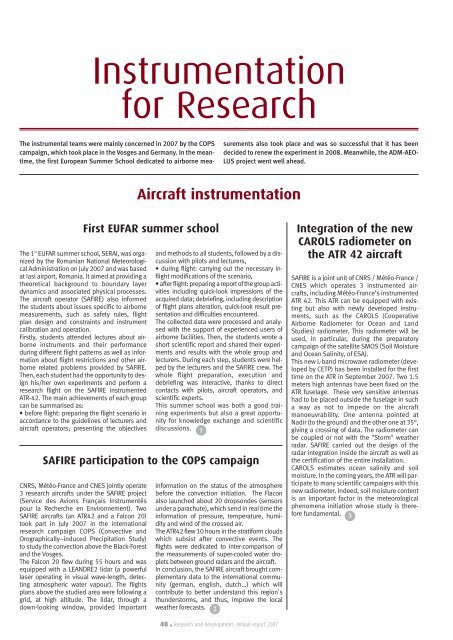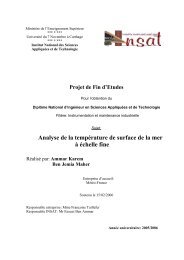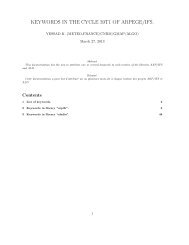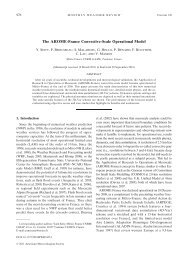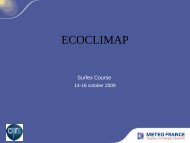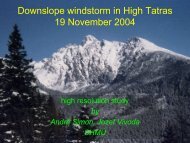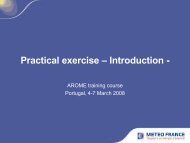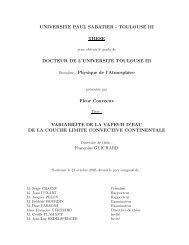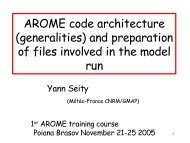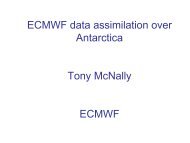3 - Centre National de Recherches Météorologiques - Météo France
3 - Centre National de Recherches Météorologiques - Météo France
3 - Centre National de Recherches Météorologiques - Météo France
You also want an ePaper? Increase the reach of your titles
YUMPU automatically turns print PDFs into web optimized ePapers that Google loves.
Instrumentationfor ResearchThe instrumental teams were mainly concerned in 2007 by the COPScampaign, which took place in the Vosges and Germany. In the meantime,the first European Summer School <strong>de</strong>dicated to airborne measurementsalso took place and was so successful that it has been<strong>de</strong>ci<strong>de</strong>d to renew the experiment in 2008. Meanwhile, the ADM-AEO-LUS project went well ahead.Aircraft instrumentationFirst EUFAR summer schoolThe 1 st EUFAR summer school, SERAI, was organizedby the Romanian <strong>National</strong> MeteorologicalAdministration on July 2007 and was basedat Iasi airport, Romania. It aimed at providing atheoretical background to boundary layerdynamics and associated physical processes.The aircraft operator (SAFIRE) also informedthe stu<strong>de</strong>nts about issues specific to airbornemeasurements, such as safety rules, flightplan <strong>de</strong>sign and constraints and instrumentcalibration and operation.Firstly, stu<strong>de</strong>nts atten<strong>de</strong>d lectures about airborneinstruments and their performanceduring different flight patterns as well as informationabout flight restrictions and other airbornerelated problems provi<strong>de</strong>d by SAFIRE.Then, each stu<strong>de</strong>nt had the opportunity to <strong>de</strong>signhis/her own experiments and perform aresearch flight on the SAFIRE instrumentedATR-42. The main achievements of each groupcan be summarised as:• before flight: preparing the flight scenario inaccordance to the gui<strong>de</strong>lines of lecturers andaircraft operators; presenting the objectivesand methods to all stu<strong>de</strong>nts, followed by a discussionwith pilots and lecturers,• during flight: carrying out the necessary inflightmodifications of the scenario,• after flight: preparing a report of the group activitiesincluding quick-look impressions of theacquired data; <strong>de</strong>briefing, including <strong>de</strong>scriptionof flight plans alteration, quick-look result presentationand difficulties encountered.The collected data were processed and analysedwith the support of experienced users ofairborne facilities. Then, the stu<strong>de</strong>nts wrote ashort scientific report and shared their experimentsand results with the whole group andlecturers. During each step, stu<strong>de</strong>nts were helpedby the lecturers and the SAFIRE crew. Thewhole flight preparation, execution and<strong>de</strong>briefing was interactive, thanks to directcontacts with pilots, aircraft operators, andscientific experts.This summer school was both a good trainingexperiments but also a great opportunityfor knowledge exchange and scientificdiscussions. 1SAFIRE participation to the COPS campaignCNRS, Météo-<strong>France</strong> and CNES jointly operate3 research aircrafts un<strong>de</strong>r the SAFIRE project(Service <strong>de</strong>s Avions Français Instrumentéspour la Recherche en Environnement). TwoSAFIRE aircrafts (an ATR42 and a Falcon 20)took part in July 2007 in the internationalresearch campaign COPS (Convective andOrographically–induced Precipitation Study)to study the convection above the Black-Forestand the Vosges.The Falcon 20 flew during 55 hours and wasequipped with a LEANDRE2 lidar (a powerfullaser operating in visual wave-length, <strong>de</strong>tectingatmospheric water vapour). The flightsplans above the studied area were following agrid, at high altitu<strong>de</strong>. The lidar, through adown-looking window, provi<strong>de</strong>d importantinformation on the status of the atmospherebefore the convection initiation. The Flaconalso launched about 20 dropson<strong>de</strong>s (sensorsun<strong>de</strong>r a parachute), which send in real time theinformation of pressure, temperature, humidityand wind of the crossed air.The ATR42 flew 10 hours in the stratiform cloudswhich subsist after convective events. Theflights were <strong>de</strong>dicated to inter-comparison ofthe measurements of super-cooled water dropletsbetween ground radars and the aircraft.In conclusion, the SAFIRE aircraft brought complementarydata to the international community(german, english, dutch…) which willcontribute to better un<strong>de</strong>rstand this region'sthun<strong>de</strong>rstorms, and thus, improve the localweather forecasts. 2Integration of the newCAROLS radiometer onthe ATR 42 aircraftSAFIRE is a joint unit of CNRS / Météo-<strong>France</strong> /CNES which operates 3 instrumented aircrafts,including Météo-<strong>France</strong>’s instrumentedATR 42. This ATR can be equipped with existingbut also with newly <strong>de</strong>veloped instruments,such as the CAROLS (CooperativeAirborne Radiometer for Ocean and LandStudies) radiometer. This radiometer will beused, in particular, during the preparatorycampaign of the satellite SMOS (Soil Moistureand Ocean Salinity, of ESA).This new L-band microwave radiometer (<strong>de</strong>velopedby CETP) has been installed for the firsttime on the ATR in September 2007. Two 1.5meters high antennas have been fixed on theATR fuselage. These very sensitive antennashad to be placed outsi<strong>de</strong> the fuselage in sucha way as not to impe<strong>de</strong> on the aircraftmanoeuvrability. One antenna pointed atNadir (to the ground) and the other one at 35°,giving a crossing of data. The radiometer canbe coupled or not with the "Storm" weatherradar. SAFIRE carried out the <strong>de</strong>sign of theradar integration insi<strong>de</strong> the aircraft as well asthe certification of the entire installation.CAROLS estimates ocean salinity and soilmoisture. In the coming years, the ATR will participateto many scientific campaigns with thisnew radiometer. In<strong>de</strong>ed, soil moisture contentis an important factor in the meteorologicalphenomena initiation whose study is thereforefundamental. 348 . Research and <strong>de</strong>velopment: annual report 2007


